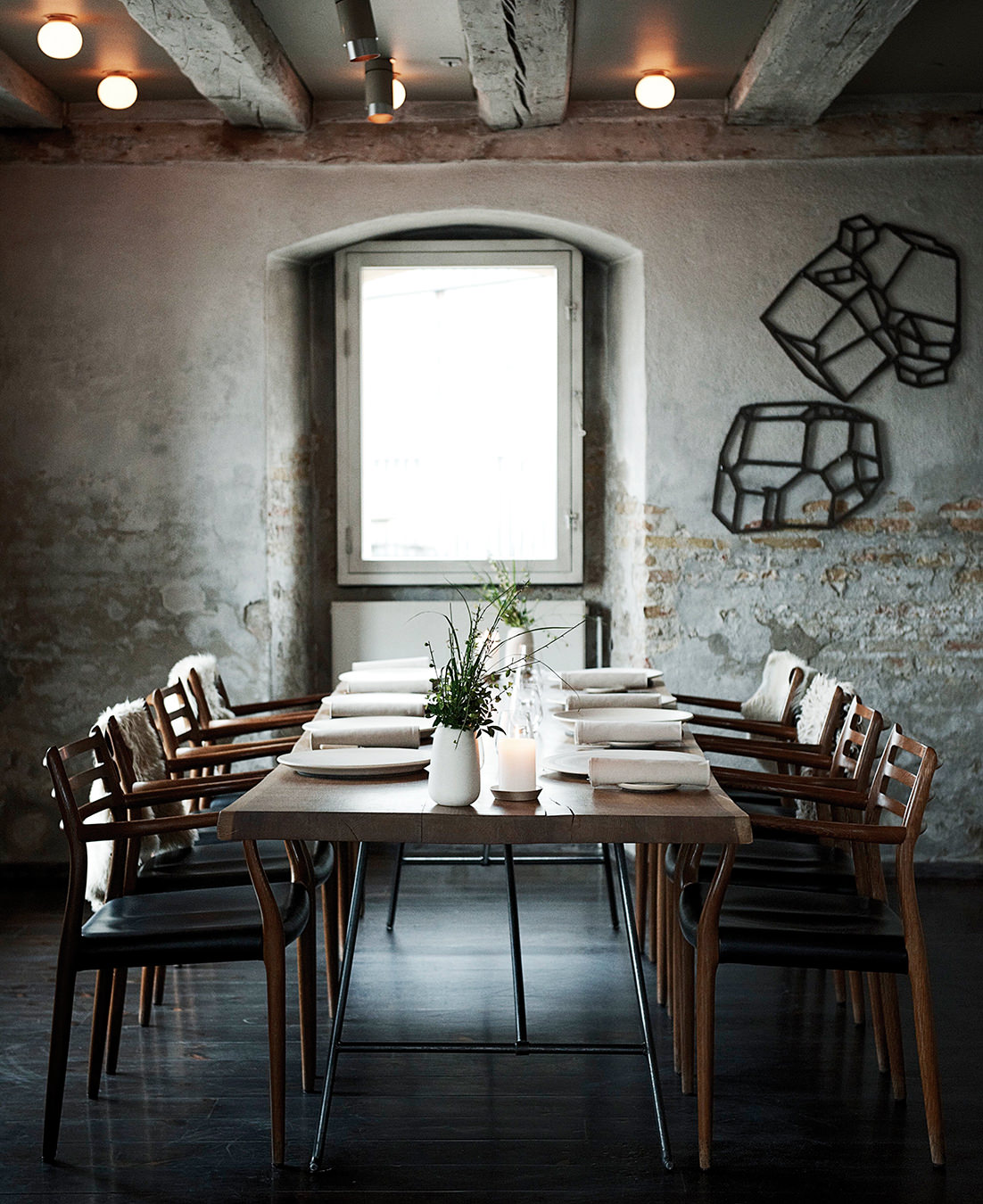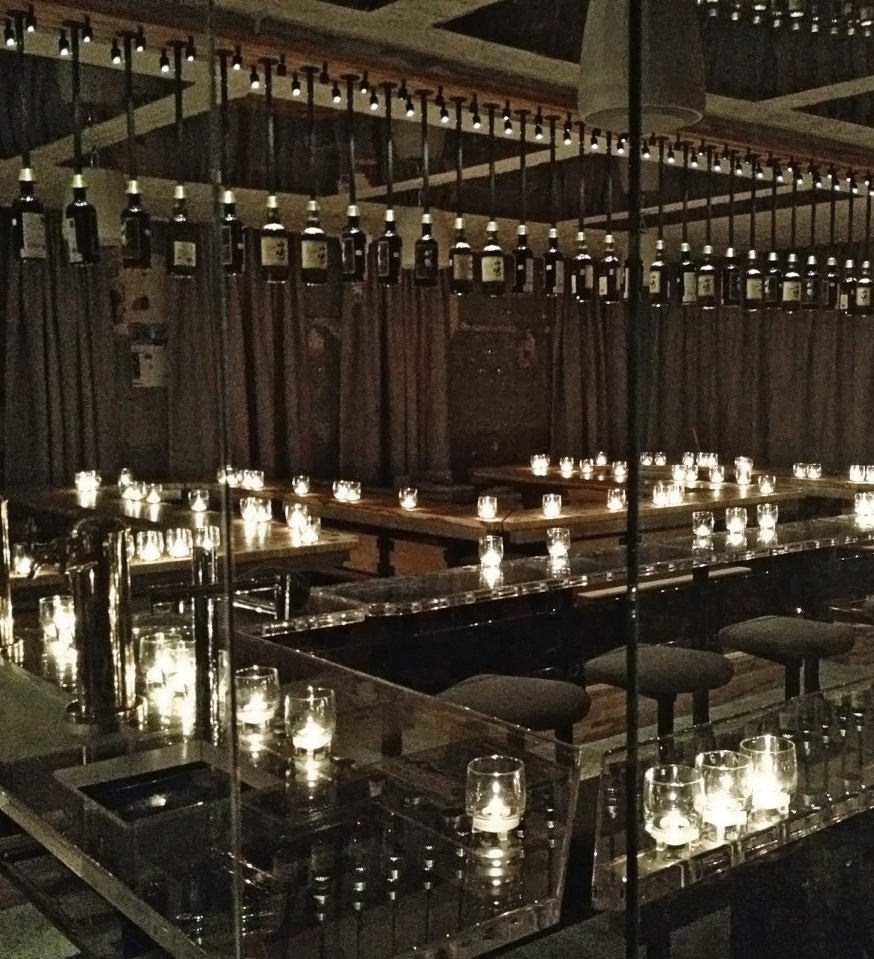Chef René Redzepi
New Nordic cuisine at Copenhagen’s Noma.
Copenhagen, a big city in a small kingdom, made global news in 2010 when chef René Redzepi’s Noma knocked Ferran Adrià’s elBulli off the number one spot on the S.Pellegrino World’s 50 Best Restaurants list (compiled and presented annually by the British magazine Restaurant). Noma topped the list again as the World’s Best Restaurant in 2011. (Adrià closed elBulli in 2011 to found a culinary foundation scheduled to open in 2014.)
Noma’s setting is in a quayside 18th-century warehouse in Christianshavn overlooking the harbour surrounded by contemporary architecture—notably Henning Larsen’s Copenhagen Opera House. Diners can wrap themselves in soft bearskins, relax on a careful selection of furniture by architect Signe Bindslev Henriksen, and welcome a new dawn of imaginative Danish cuisine. The omnivorous René Redzepi is reinventing Nordic cuisine with an innovative gastronomic approach.
“We’re just about to have our team meeting,” says Redzepi. He gathers the two dozen chefs around, while snacking on an apple. “I think we need to start by introducing all the new faces we have here. So for those of you who started today as a stage, this is a great moment to introduce yourself to the full team,” he says. Robert, from Edinburgh, starts, saying, “I’ll be here for just one week—unfortunately.” Replies Redzepi, “As punishment, you’ll have to do haggis for us one night.” Nine other stagiaires—including two from Bolivia, one from Colombia, and three from Mexico—introduce themselves. “Guess we’ll be taking salsa lessons here on weekends from our Latin American section,” says Redzepi with a smile.
Noma books up three months in advance; for a 12-table restaurant that’s been reconfirmed as the best in the world, it’s understandable. The charismatic Redzepi is the kind of pioneer who attracts talent from all over the globe—16 nations are represented in the kitchen. As a result, Noma has become an innovation lab of ambitious young chefs, which, in turn, has made Copenhagen a destination on the culinary world tour.
“News from the kitchen?” asks Redzepi. A menu change—crab as the first serving on the seven-course menu and razor clam on the 12-course—is announced. And venison instead of hare for the sole meat course. On the tableside serving, the pile of herbs will be parsley and lovage.
“Right. Perfect. Let’s have a good evening,” says the chef.
“Copenhagen [cuisine] today is very vibrant,” says Redzepi as we walk through the state-of-the-art kitchen. “It’s at an infant stage. Of course, gastronomy has been here for a while, but this idea that we’re trying to explore our own history, our own culture, and our own soil, is recent. There is this energy here that is quite special for our region and unique as well.” Noma is about wild produce foraged by hand, horse mussels sourced from the Faroe Islands, muskox from Greenland, and skyr curd from Iceland.
Redzepi’s culinary philosophy is sourcing from the Nordic terroir local and sustainable produce whose characteristics are particularly excellent. The countryside and cultural landscape is unique due to favourable climatic conditions, in spite of the northern location. Redzepi has revolutionized Nordic cuisine by embracing indigenous seasonal ingredients to create an imaginative menu with distinctive flavours and a unique character. He works closely with many individual suppliers, many of whom forage produce exclusively for Noma. “It’s the ingredients that guide us, the dialogue we have with people in the wilderness or farmers,” he says. “Those are the ones who tell us what’s in season, and with that we change our menu.”
If you want to understand the big idea behind Noma, you need simply experience René Redzepi’s signature dish: the hen and the egg. Diners are invited to prepare it themselves.
If you want to understand the big idea behind Noma—and new Nordic cuisine—you need simply experience René Redzepi’s signature dish: the hen and the egg. Diners are invited to prepare it themselves. A plate of slightly wet hay is served, with a 280-degree-hot pan on top. You are directed to add some hay-infused oil to the pan, and then crack a wild duck egg into the oil. When two minutes have expired, you are instructed to add thyme butter into the pan and then sauté a few wild ramsons and spinach leaves. After three and a half minutes, a chef brings over a saucepan of wild ramsons sauce, which he spoons over the cooked egg. You then sprinkle herbs and wild plants over the egg dish, and crumble some potato chips overtop. This imaginative creation reflects sensory aromas of the natural Danish landscape.
Redzepi’s Nordic cuisine possesses a certain purity, an essential simplicity, and the clever use of seasonal ingredients—with creative flair. These values are reflected in the composition and presentation of each dish and in the planning and preparation that underlies it all.
Redzepi, the son of a Danish mother and an Albanian father, grew up in Copenhagen and began cooking when he was 15. He started as an apprentice at the Pierre André restaurant in Copenhagen, and then went on to work at elBulli in 1999 and in 2001 at the French Laundry with Thomas Keller, before returning to work at Kong Hans Kælder in Copenhagen. Redzepi obviously has some indefinable talent as well; he was approached by another Nordic cuisine pioneer, Claus Meyer, to open Noma in 2003, when Redzepi was only 25.
Noma’s wine list, while largely French, complements the unconventional cuisine, and now includes wine from a vineyard that Meyer owns on Lilleø, one of the smallest islands in Denmark’s North Sea. “Here,” says Redzepi, handing me a bottle of 2009 Lilleø Vin Arwen (Sydhavsøerne, Denmark). “It’s our wine named after my daughter.” A blend of solaris, sauvignon blanc, riesling, and silvaner, the 2009 Arwen, Lilleø Vin, is a collaboration between chef and winemaker Anders Selmer (a former protégé of Redzepi), Meyer, and Redzepi.
There are two major culinary movements in haute cuisine at the moment: the use of local, sustainable, organic, and seasonal ingredients; and the use of innovative technologies in modernist cuisine. Noma, with its modern techniques and commitment to quality ingredients from the Nordic environment, has fashioned its own cuisine, which straddles both movements. Redzepi is one of the most influential chefs in the world, and has successfully used culinary innovation to build his brand. His drive and ambition will undoubtedly get him that next Michelin star. (Despite holding the World’s Best Restaurant title, Noma failed to win a third Michelin star in the 2011 ratings. The restaurant has maintained its second Michelin star since 2007; its first Michelin star was awarded in 2006.) Redzepi has also published his first cookbook, Noma: Time and Place in Nordic Cuisine, and he is starting to appear on TV—he cooked on the BBC series MasterChef: The Professionals in 2010.
So, as Redzepi has rolled out the initial part of his cultural movement, now what? His accolades are “a great tool to fill up the restaurant,” he says, but “the end goal has to be the whole idea of shaping a cuisine and pushing this momentum forward.” Redzepi has one of the most distinctive and unique approaches to cuisine in the world. His new Nordic cuisine is reaching a wider audience, and for this, he has our gratitude. It’s why Noma, in a converted warehouse in Copenhagen—where trading ships once unloaded fish and skins from Greenland, Iceland, and the Faroe Islands—could be considered the best restaurant in the world.
Noma topped the list again as the World’s Best Restaurant in 2012, took second place in 2013, reclaimed first in 2014, and took third place in 2015.
Photos by Ditte Isager.







